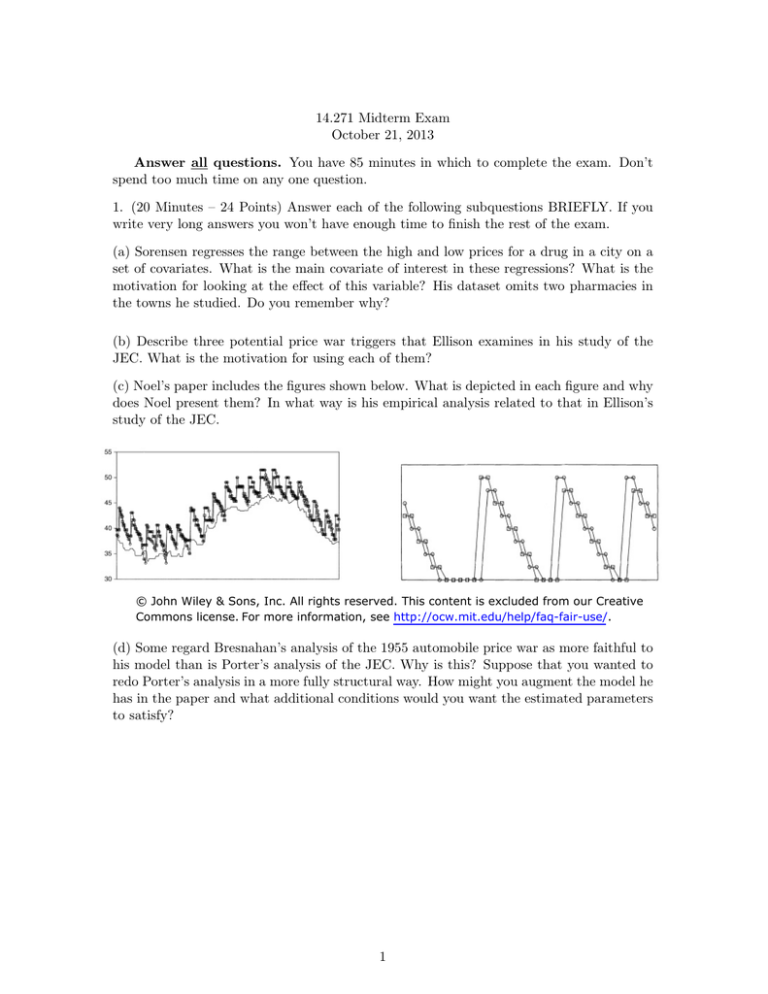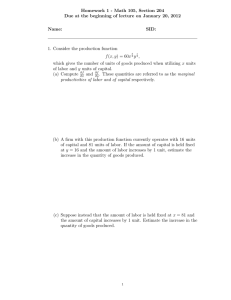
14.271 Midterm Exam
October 21, 2013
Answer all questions. You have 85 minutes in which to complete the exam. Don’t
spend too much time on any one question.
1. (20 Minutes – 24 Points) Answer each of the following subquestions BRIEFLY. If you
write very long answers you won’t have enough time to finish the rest of the exam.
(a) Sorensen regresses the range between the high and low prices for a drug in a city on a
set of covariates. What is the main covariate of interest in these regressions? What is the
motivation for looking at the effect of this variable? His dataset omits two pharmacies in
the towns he studied. Do you remember why?
(b) Describe three potential price war triggers that Ellison examines in his study of the
JEC. What is the motivation for using each of them?
(c) Noel’s paper includes the figures shown below. What is depicted in each figure and why
does Noel present them? In what way is his empirical analysis related to that in Ellison’s
study of the JEC.
© John Wiley & Sons, Inc. All rights reserved. This content is excluded from our Creative
Commons license. For more information, see http://ocw.mit.edu/help/faq-fair-use/.
(d) Some regard Bresnahan’s analysis of the 1955 automobile price war as more faithful to
his model than is Porter’s analysis of the JEC. Why is this? Suppose that you wanted to
redo Porter’s analysis in a more fully structural way. How might you augment the model he
has in the paper and what additional conditions would you want the estimated parameters
to satisfy?
1
2. (20 Minutes – 28 Points)
Consider a variant of the standard durable goods model. A monopolist sells a durable
good to a continuum of consumers with types θ ∈ [0, 1]. Consumers derive utility both
from using the good and from being able to tell later purchasers that they owned the good
before them. Specifically, assume that a type θ consumer gets utility 2θ − p1 + x2 if he
purchases the good at price p1 at t = 1 and x2 consumers later purchase at t = 2, θ − p2 if
he purchases at price p2 at t = 2 and utility 0 if he does not purchase.
(a) Consider first the noncommitment model in which the monopolist’s price at t = 2 must
maximize period 2 profits. What price does the monoplist set at t = 2 if it has sold to all
consumers with θ ∈ [θ1 , 1] at t = 1? What price does the monopolist set at t = 1?
(b) Now suppose that the monopolist can commit to a sequence of prices (p1 , p2 ). What
prices will the monopolist choose?
(c) In class I showed two properties of a standard two-period durable goods model: in the
commitment model the firm sells no units at t = 2, and the monopolist earns lower profits
in the noncommitment model. Briefly (but with some formality if you can) sketch the
argument for these two results. Where in the proof would the argument break down if you
had tried to generalize those proofs to this model?
3. (20 Minutes – 24 Points)
Consider a two-type model of price discrimination without unit demands. A monopolist
produces a divisible good at a constant marginal cost of zero. There is a unit mass of
consumers. They may buy any nonnegative real number of units of the good. Half of the
consumers are type θ = 1. Each has inverse demand function P1 (q) = 1 − q. The other half
of consumers are of type θ = 2. Each has inverse demand function P2 (q) = 1 − 12 q 2 .
(Note that I have given you inverse demand curves rather than valuations v(q, θ). They are
related by v(q, θ) = 0q P (x, θ)dx.)
(a) Consider first the best situation from the monopolist’s perspective: suppose that θ is
observable and the monopolist can charge any tariff T (q, θ), i.e. the firm can use nonlinear
prices and can set separate prices in the two populations with no worries about monitoring,
arbitrage, etc.
(b) Now assume that the monopolist is much more limited: assume that θ is unobservable
and that the monopolist can monitor which consumers are using the good, but cannot
prevent resale among the consumers. Hence, the only feasible tariffs will be two part tariffs
of the form T (q) = A + pq.
Show that the optimal policy for the monopolist will have p > 0.
(c) What about this situation is different from the textbook example of two-part tariffs
where the monopolist sets p = c and extracts all the surplus using a fixed fee? Can you
give any intuition for why this makes a positive price desirable?
2
4. (20 Minutes – 24 Points)
Consider two coffee shops indexed by i = 1, 2. Assume that they serve three groups of
consumers. Consumers in groups 1 and 2 only drive by one shop: the consumers in group i
buy one cup of coffee from shop i if the price is less than $3 and otherwise do not purchase
anything. Consumers in group 3 learn the prices at both stores and then buy from the
lowest price firm provided the price is less than $3.
Assume that firm 1 is in a more popular location than firm 2: half of all consumers are
in group 1, one-quarter are in group 2, and one quarter are in group 3.
Consider the simultaneous move pricing game where firms 1 and 2 simultaneously choose
price p1 and p2 and all consumers then shop as in the model above.
(a) Say as much as you can about what the equilibrium can’t look like. Don’t take
the time to write out formal proofs, but try to give quick informal descriptions of how you
know these things.
(b) Find a Nash equilibrium of the game.
3
MIT OpenCourseWare
http://ocw.mit.edu
14.271 Industrial Organization I
Fall 2013
For information about citing these materials or our Terms of Use, visit: http://ocw.mit.edu/terms.










